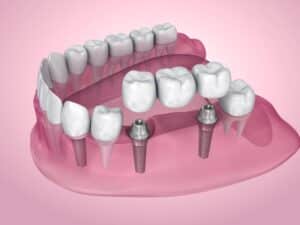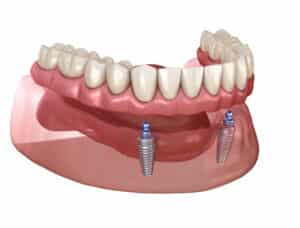Dental Implants To Restore Your Smile
Whether you’re missing one tooth or multiple teeth, it can quickly start to impact your life. However, you’re not doomed to a life of wearing dentures or hiding gaps in your smile—you can still enjoy a complete smile thanks to dental implants. Thanks to modern restorative dentistry, we can restore missing teeth in a way that looks, functions and feels just like your natural teeth.

Why We Recommend Implants
- They’re as close to having natural teeth as you can get!.
- Their biocompatible nature means they’re unlikely to be rejected by your surrounding gum and bone.
- They’re a flexible restoration that can be used to replace one tooth, a few adjacent teeth or an entire arch of teeth.
- Implants are fixed in place just like natural teeth, which means they don’t slip out of place or trap food like other restorative options.
What are Dental Implants?
Your tooth is anchored to your gums and jawbone by your tooth roots. That’s why when you loose a tooth, you can’t simply pop a crown on and carry on—the crown needs something to be anchored to.
Dental implants have been designed to act like those missing roots, to provide a stable foundation to place restorations like crowns, bridges and even full arches.
How We Can Replace Missing Teeth

Single Tooth Implants
If you're missing a single tooth, we can replace it with a strong and lifelike implant using a ceramic crown as the restoration.

Implant-Supported Bridges
When you're missing a few teeth in a row, we can secure a porcelain bridge to implant posts to fill the gap in your smile.

All-On-4 Dental Implants
When you're missing an entire arch of teeth, Dr. Ganti can use the arch on 4 technique to secure a prosthetic arch to just 4 implants.
Are You a Candidate?
- You are missing one, multiple or all teeth due to periodontal disease, trauma or ageing.
- Your jaw has reached full maturity.
- You are in good overall health without any uncontrolled conditions that can hinder proper healing.
- You do not have any active gum disease or are currently having it treated before your implant placement.
- You are committed to maintaining good oral hygiene and attending regular check-ups are your treatment.
What To Expect
When visiting us for your implant placement appointment, we will begin by numbing the area of your mouth that will be worked on. Dr. Ganti will then make a small incision to place the titanium implant post. The implant will then be placed in your jawbone and will go through a period of osseointegration in which the implant and jawbone fuse together. This takes around 6 months for most patients. Once healed, we’ll make a special crown that fits over the implant’s abutment to finish off your smile.
Meet Your Oral Surgeon
Dr. Ajay Ganti is a highly experienced and respected oral surgeon specializing in dental implant procedures. With a commitment to excellence and patient care, he utilizes the latest techniques and technology to ensure optimal results. Reach out today to book your initial consultation with Dr. Ganti.


